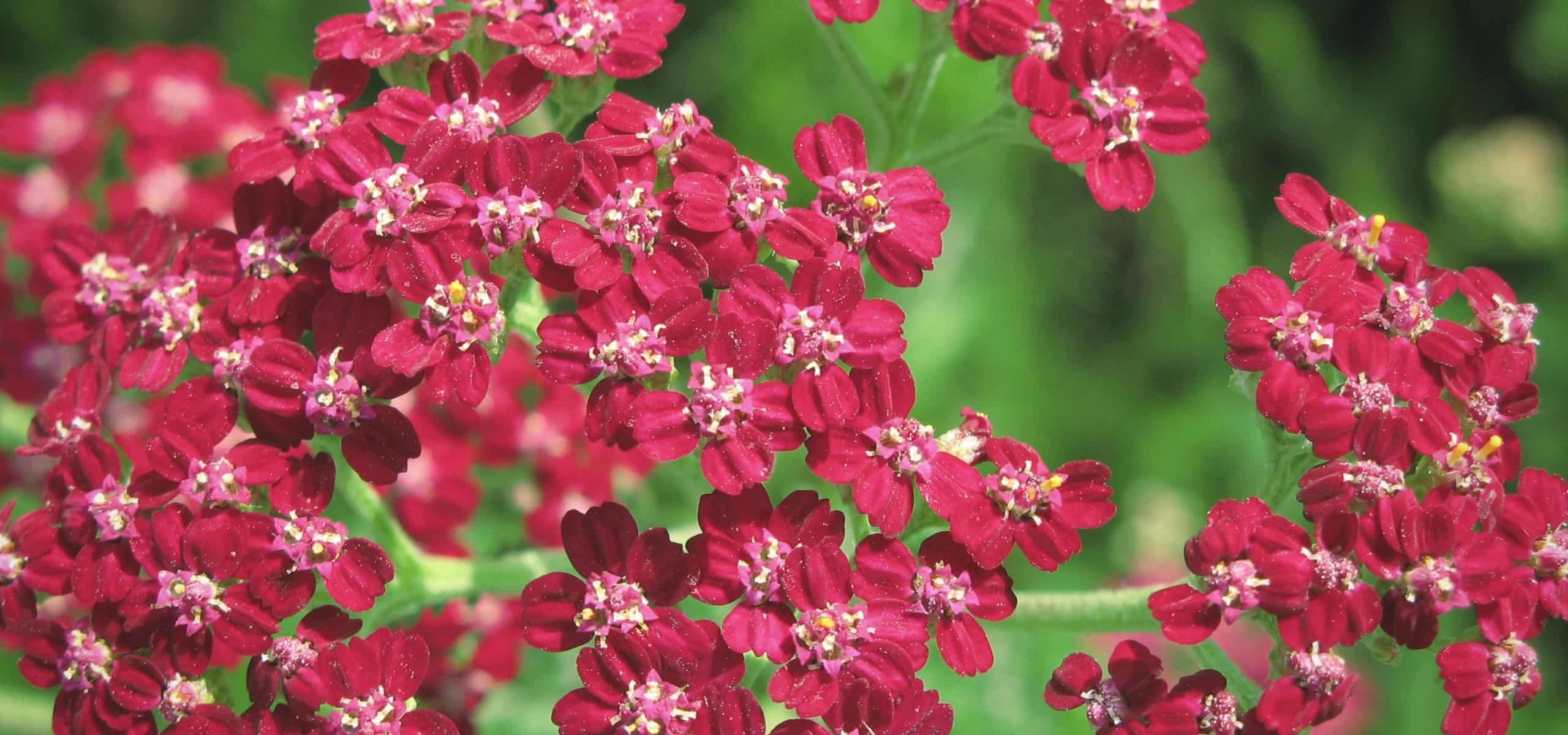
Achillea: 7 successful companion planting ideas
to integrate them well into your flower beds
Contents
The yarrow is an easy-to-grow perennial, whose long-lasting summer flowering adds a wild and natural touch to the garden. The most common is the common yarrow, which is white in colour, but it can also be red, pink, or yellow.
With its wide range of colours, it enlivens rockeries, naturalistic gardens, or borders, bringing dynamism and vitality. Yarrow creates a more beautiful effect when planted in groups, reminding us of wildflower fields. Their height varies depending on the varieties, but generally, they are best placed in the middle of borders, behind shorter plants. They have a straight and graphic architecture, and particularly delicate foliage. The yarrow is undoubtedly a plant that brings a lot of lightness to the garden!
How and with which plants should they be associated? In what style of garden do they find their place? Discover our ideas and inspirations for installing yarrow in your garden!
For everything you need to know about yarrow, check out our Guide to planting, growing, and maintaining yarrow
In a rockery
Withstanding both heat and drought, yarrow easily fits into rock gardens. Opt for compact varieties, such as this yellow yarrow, Achillea tomentosa. Its spreading habit makes it particularly suitable for this use. Pair it with other plants that thrive in dry, sunny environments. You can plant alongside it some clumps of sedums, sweet alyssum (Lobularia maritima), saxifrages, or Convolvulus cneorum. Add some height by planting lavenders and euphorbias. Avoid varieties like Achillea ptarmica ‘The Pearl’ or ‘Perry’s White’: they prefer cool, heavy soils and slightly shaded locations!

Convolvulus cneorum, Achillea tomentosa and Lobularia maritima (photo Carl Lewis)
Read also
Achillea : plant, cultivate and maintainFor a natural garden!
With its free habit and airy flowering, yarrow is perfect for creating a country-style garden. Plant your yarrows in groups, at a rate of 6 young plants per m², to create a beautiful effect of a wildflower meadow! Place it with plants that have a free and airy habit. Prefer grasses such as Stipa tenuifolia or Pennisetum. And add some summer-flowering and airy perennials: Verbena bonariensis, Gaura lindheimeri or Cirsium japonicum are must-haves. You will be able to pick bouquets and create stunning floral arrangements.
Thus, you can create a remarkable naturalistic garden with warm tones, by combining Achillea ‘Terracotta’ with the orange flower spikes of Eremurus ‘Cleopatra’, accompanied by the white flowering of Selinum wallichianum and the golden reflections of the grass Stipa arundinacea. These plants with a free habit and tall architecture will bring a lot of lightness to your garden.
Find more inspirations here!
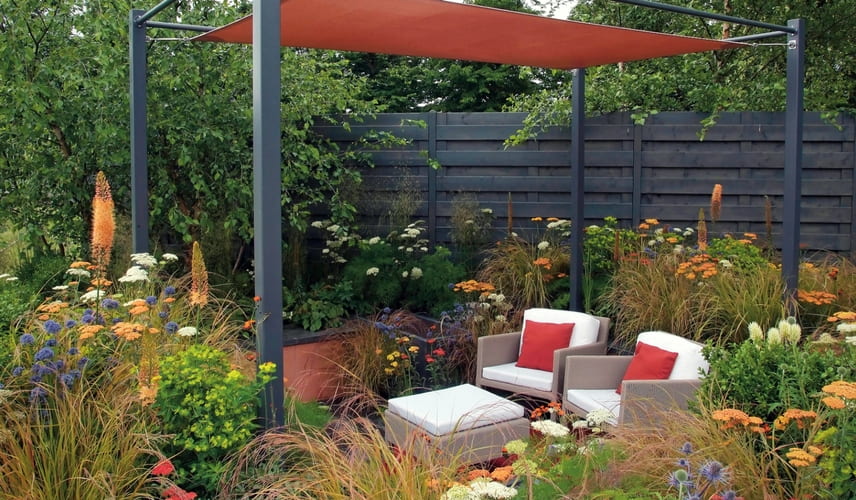
A combination with Achillea ‘Terracotta’, Eremurus ‘Cleopatra’, Selinum wallichianum and Stipa arundinacea. (Copyright-AC Nathalie Pasquel MAP – Landscape designer Catherine MacDonald)
Discover other Achillea
View all →Available in 0 sizes
Available in 1 sizes
Available in 1 sizes
Available in 2 sizes
Available in 1 sizes
Available in 1 sizes
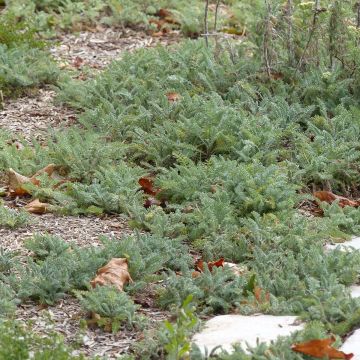
Available in 2 sizes
Available in 1 sizes
Available in 2 sizes
Available in 2 sizes
In a vicarage garden
Yarrow will easily find its place in a vicar’s garden. This is a utilitarian garden where medicinal, aromatic, and vegetable plants are cultivated, as well as fruits and flowers. Insert boxwood along the edges and a few yews to structure the garden. Add vegetable plants, such as sorrel, parsnip, or fennel. Leave plenty of space for aromatic and medicinal plants (sage, hyssop, summer savory, mint…). You can thus plant Achillea millefolium ‘Wonderful Wampee’ alongside a few clumps of lovage, agastache, Centaurea montana, comfrey, or mallow.
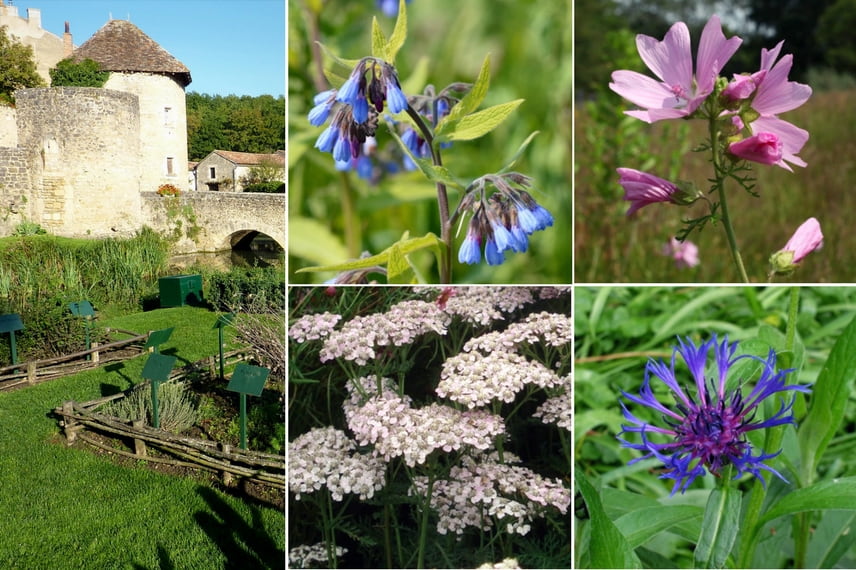
Symphytum azureum, Malva moschata ‘Rosea’, Achillea ‘Wonderful Wampee’ and Centaurea montana
In a Mediterranean garden
Appreciating sunny and rather dry soils, yarrow allows for the creation of Mediterranean-style gardens. Create a mineral arrangement with stones and choose plants suited to drought. Pair yarrow with silver foliage, such as that of Santolina or Jerusalem sage (Phlomis fruticans). Add some aromatic plants like rosemary or lavender, and grasses: Stipa tenuifolia or Festuca glauca. If you have space, plant a few bushes, such as cypress, olive trees, or oleanders for their colourful flowering. In addition to being ecological, low in water and fertiliser needs, this type of garden will require very little maintenance!

Lavender, yarrow and Jerusalem sage (Phlomis fruticosa. Photo C. T. Johansson)
In an English mixed border
Create a colourful and vibrant mixed border, typical of English gardens. Position your flowerbed in front of a monochrome hedge to highlight the flowering and the design of the plants. Indulge in varieties with colourful and tangy flowerings, such as Achillea ‘Cerise Queen’ with its purplish-pink flowering or Achillea ‘Walther Funcke’ with orange flowers. They will bring vitality to your flowerbeds! For a garden rich in colours, plant them alongside agapanthus, echinaceas, or cosmos.

Echinacea purpurea, Achillea ‘Walter Funcke’ and Cosmos bipinnatus
In a cottage garden
Compose a cottage garden with a natural and delicate style, favouring mauve, blue, and white flowerings. With its soft pink flowers, Achillea ‘Apple blossom’ fits perfectly into this type of garden. Direct a clematis or climbing hydrangea (Hydrangea petiolaris) against the wall of your house. Plant some delphiniums, foxgloves, lupins, or lavateras in front of them. You will achieve a garden with lush vegetation and pastel shades, giving it much charm and romance.
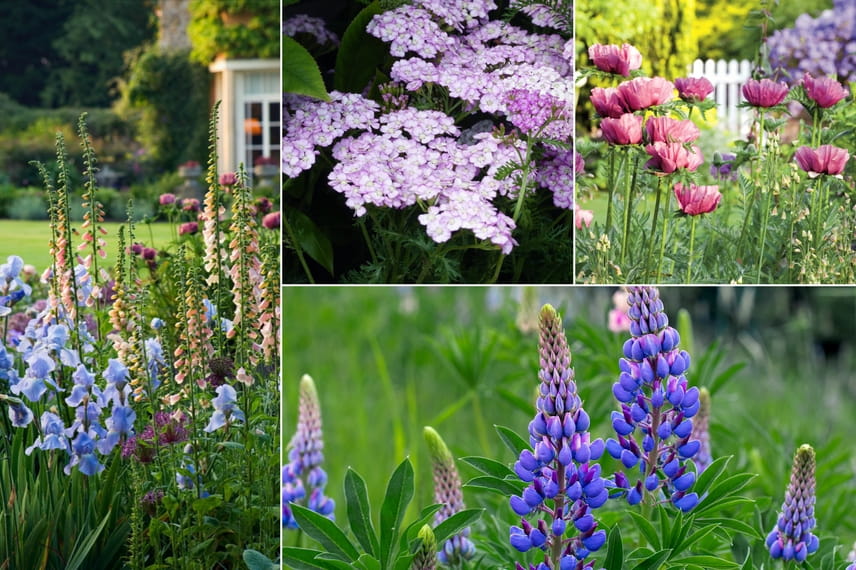
Iris ‘Jane Philipps’ and Digitalis ‘Suttons Apricot’ (Haselbech Northamptonshire – Photo credit MAP), Achillea ‘Apple blossom’, Papaver ‘Pattys Plum’ (Copyright GAP Photos – Mark Bolton) and Lupins.
To play with colours!
Mix colours and play with contrasts by pairing, for example, yellow-orange varieties with flowers in mauve or violet tones. You can plant Achillea ‘Terracotta’ alongside Origanum ‘Rosenkuppel’, Stachys ‘Hummelo’ and Sanguisorba ‘Red Tip’. Orange or yellow varieties also pair wonderfully with the golden foliage of grasses, adding a very graphic element to your borders.
Give your garden an exotic flair by combining achilleas with other flowers in warm tones. You can marry achilleas ‘Feuerland’ or ‘Walther Funcke’ with Hemerocallis, Kniphofias, Dahlias or Crocosmias. Don’t hesitate to add some purple foliage to highlight these vibrant flowers.
Finally, you can bring vitality to your borders by combining zesty colours: pink, orange, peach or lemon yellow. Grow Achillea ‘Moonshine’, ‘Terracotta’ or ‘Lilac Beauty’ alongside asters or cosmos in bright shades.
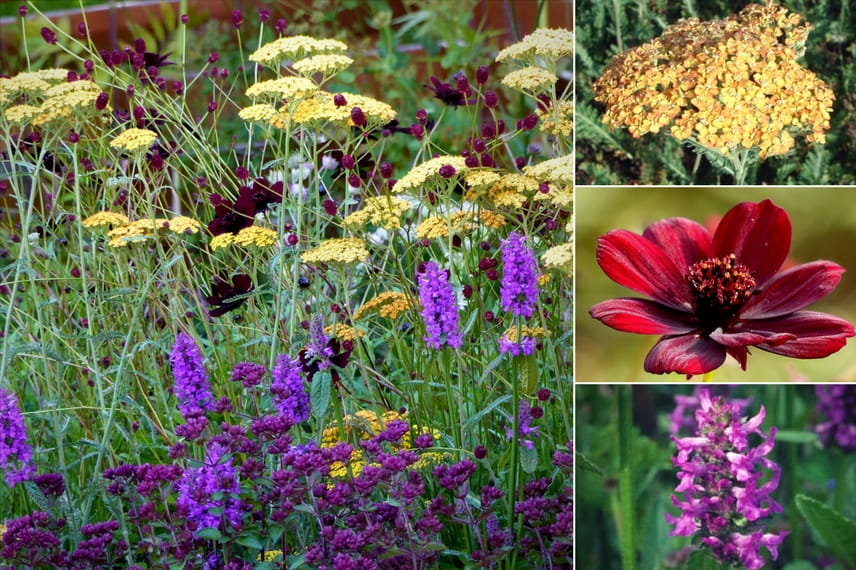
A combination featuring Achillea ‘Terracotta’, Cosmos atrosanguineus, Stachys ‘Hummelo’, Origanum ‘Rosenkuppel’ and Sanguisorba ‘Red Tip’
- Subscribe!
- Contents

































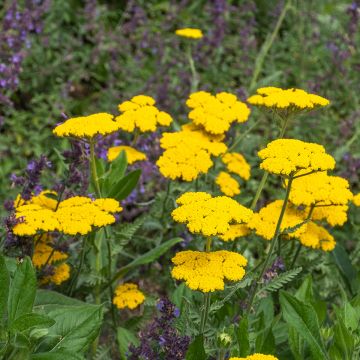
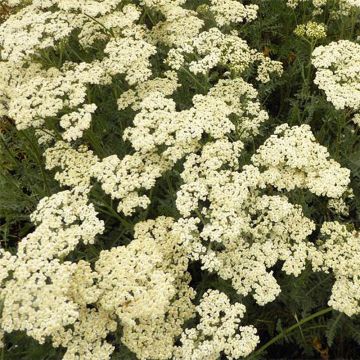
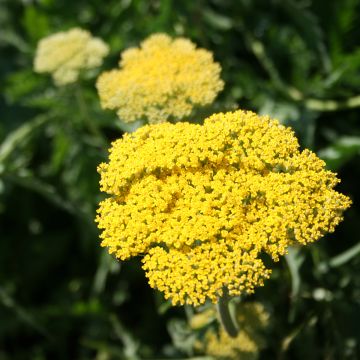
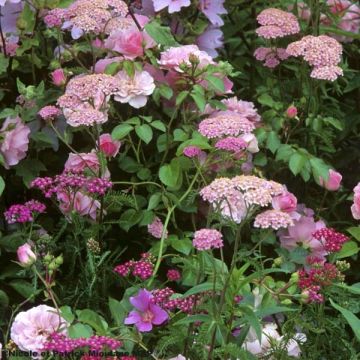
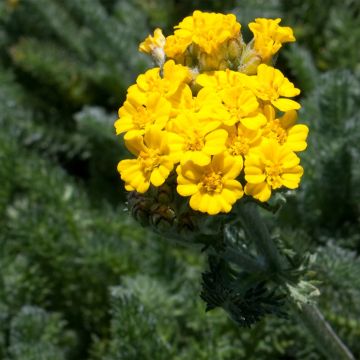
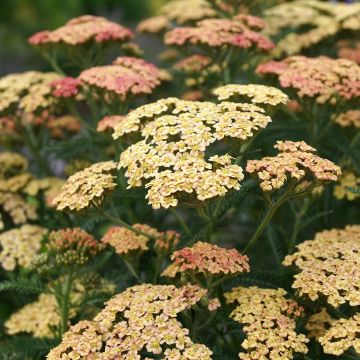
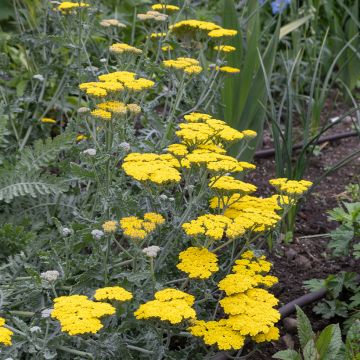
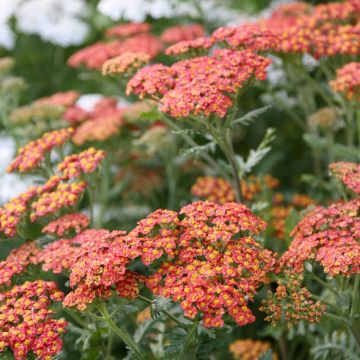
Comments